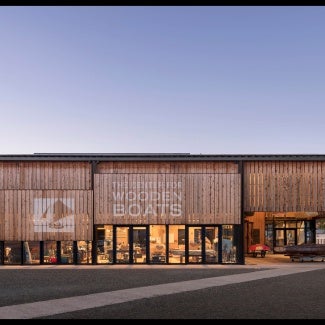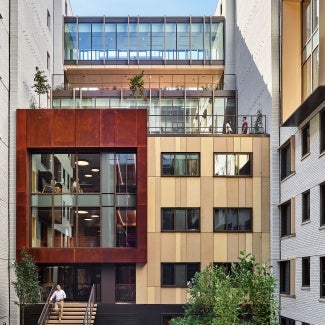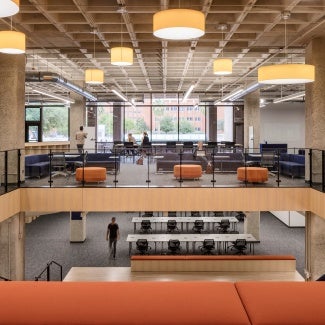633 Folsom
The award-winning contemporary architecture of 633 Folsom in San Francisco renovates and reanimates the commercial building to the demands of a modern workforce while reducing embodied and operational carbon.

Project highlights: 633 Folsom
- Architect: Gensler
- Owner: The Swig Company
- Location: San Francisco
The reuse of 633 Folsom, a commercial building in San Francisco, is a story centered on the reduction of embodied and operational carbon and the reanimation of a vital urban corridor. When a very rare full-building vacancy approached, the owner and original developer of the 1967 building turned to the design team for a renovation that would address the demands of a modern workforce and the rapidly evolving neighborhood.
The Swig Company, 633 Folsom’s owner, sought a new design that focused on the well-being of its occupants and access to daylight, critical components of future occupancy. Building performance and aesthetics also needed to support the surrounding neighborhood’s increasingly pedestrian qualities. In the end, the project resonated with the leadership of Asana, a popular work management platform, which leased the entire building for its headquarters.
The black glass that adorned the original building lent it a foreboding feeling along the sidewalk and throughout the interiors. 633 Folsom’s new facade stands in stark opposition, conceived to respond to the built and natural environment with sunshades of varying depths running along it. The shades’ final geometry and orientation, optimized through the team’s rigorous computational modeling, give the building its unique identity and an interior workplace with significantly more daylight. Inside, its occupants can collaborate with the blinds open for additional hours due to the building’s shading capacity.
The shades are composed of fiber-reinforced polymer, which offers flexibility in form and low weight. Throughout the day, the shades also catch the shifting value of light, engaging both occupants and passersby. Inside, they go largely unnoticed, while from the outside they create a bold urban expression on an otherwise unremarkable city block.
In multiple meetings during the project’s conceptual development, several community groups offered input on ways the building’s additional floors could preserve light and air for residential buildings to the east. Though the building is privately owned, its publicly occupied landscape helps animate the edge of Folsom Street, where sculptural work by California-based artist Sam Falls is integrated into its terraced forms.
Among San Francisco’s many new glass office buildings, 633 Folsom’s exterior brings new materiality and texture to the street and pedestrian experience. The building’s reinvention also demonstrates how careful architecture can expand an existing structure without diminishing its context and how developers can build sustainability within their social responsibilities.

Project team & Jury
Sustainability Consultant: Atelier 10
Façade Consultant: Wiss Janny Elstner
Engineer - Civil: BKF
Engineer - MEP: Meyers+
Engineer - Structural: Tipping Structural Engineers
General Contractor: Plant Construction
Landscape Architect: Mantle Landscape
Ashley Wilson, FAIA, Chair, Ashley Wilson Architect, Alexandria, Va.
Jose Leo Arango, Assoc. AIA, EYP, District of Columbia
Randall Deutsch, FAIA, University of Illinois at Urbana-Champaign School of Architecture, Champaign, Ill.
Gabriel Ignacio Dziekiewicz, AIA, DesignBridge, Chicago
Teresa Jan, AIA, Multistudio, San Francisco
Luis Nieves-Ruiz, East Central Florida, Regional Planning Council, Orlando, Fla.
Zakiya Wiggins, AIA, LS3P, Raleigh, N.C.
The 2023 Architecture program celebrates the best contemporary architecture regardless of budget, size, style, or type. These stunning projects show the world the range of outstanding work architects create and highlight the many ways buildings and spaces can improve our lives.
Sixteen projects showcase the best contemporary architecture.



